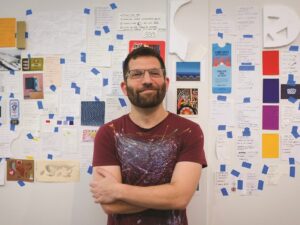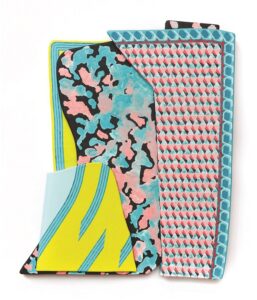Mark Joshua Epstein is not afraid of excess. In his paintings, saturated hues and whimsical patterns bump up against asymmetrical frames. Some pieces jut out from the wall in precisely shaped topographies; others cave in like a valley lined with loud wallpaper. All are abstract and non-rectilinear, forcing viewers to twist their heads to look for meaning in the seeming chaos.

“I am always trying to play with the boundaries of good and bad taste,” says Epstein, who is a current fellow at the Fine Arts Work Center in Provincetown. “I got accused in college once of being a ‘bathroom painter.’ ” Epstein surmises this meant that his professor thought he used too much white in his colors, which rendered them too bright and gaudy.
“For me, my paintings are always elegant,” he says. “They’re never bad taste on purpose. I just think my inherent taste is slightly bad. But I do want people to look at my paintings and think, ‘Oh, this guy actually seems capable of making a tasteful, elegant painting, but he made the choice not to.’ ”
Epstein has always been drawn to vibrancy. As a self-described “East Coast Jew” growing up in Rockville, Md. — in an observant Jewish household in a Jewish neighborhood — he didn’t find much color in his environment. “The only colors my parents believed in were beige and blue,” Epstein says. “My family was wonderful but very observant. And I attended a very observant Jewish day school, which was not so wonderful. So, from very early on, I was looking elsewhere for inspiration.”
In high school he discovered the magazine Nest, an iconoclastic interior design journal featuring work that was rarely conventional or minimalistic. And he visited his grandfather, who owned a furniture store on Long Island filled with late-’80s objets and Art Deco anachronisms.
But Epstein also started to notice beauty in his everyday surroundings. He took cues from houses decorated with ceremonial objects for various Jewish holidays and from the art of micrography, a traditional form of Jewish calligraphy in which small Hebrew letters are used to form designs and objects. Both would come to influence his painting practice. (The shapes of the paintings themselves are inspired by 19th-century papercuts made by Eastern European Jews, who hung the intricately bordered paper works around their houses as talismans to bring good fortune. “So much of the decorative elements of my parents’ house has stuck with me,” Epstein says.)

As Epstein drew inspiration from his family’s religious traditions, his family began to adjust to his sensibilities, too. “As a teenager, they let me choose a color for my room, and I chose an incredibly saturated turquoise,” Epstein said. “To their credit, they were fine with it.”
Epstein’s early exposure to decorative arts and interior design has allowed him to bridge what he sees as an artificial barrier between applied and fine art. “I think a lot of why decorative arts aren’t considered to be the same caliber as fine arts has to do with misogyny,” Epstein says. “Applied arts are thought of as the woman’s domain.”
Accordingly, Epstein questions the conventions of design and decoration and asks why art has to adhere to certain constraints. “There’s conventional wisdom in interior design and fashion that if you wear one pattern, you have to offset it with a solid,” Epstein said. “Why do we need to do that? I’m much more thrilled by things that aren’t supposed to go together going together. The most interesting thing for me is when a pattern meets a pattern. I want them to be talking to each other. I want there to be quiet interactions, but sometimes I want arguments, and sometimes I want romance.”
Epstein sees this as being an inherently queer quality of his paintings — and many queer viewers have told him the same thing. During an open studio night at FAWC, Epstein was visited by many gay men. “They all recognized the inherent queerness in my paintings,” says Epstein. “Part of the work of looking at abstraction is finding significance between the lines. It requires a little extra scrutiny to extract meaning.”
He also enjoys the fact that his art may not always be legible to a general audience. “We are sold this idea that the most powerful strategy for marginalized populations is visibility, but I think there is an equal amount of power in camouflage and abstraction,” Epstein says. “There is something cool about a spectator feeling that something is in these paintings that might not be noticed by everybody. Some of my more recent paintings, for example, have intricate borders that could be readable to certain people who grew up with Jewish iconography. I think a lot about the value of encoding identity in abstraction.”
Epstein currently lives in Ann Arbor, Mich. with his husband and teaches two-dimensional design at the University of Michigan. They just bought a German Lutheran church, built in 1892, which they will be refurbishing into a home and art studio. The studio will be in the church’s sanctuary, where towering geometric stained-glass windows filter in pastel-colored light — a detail that Epstein finds consistent with his sensibilities.
“There’s something ironic about two homosexuals — one very Jewish — moving into a church together,” Epstein says, recalling the time when a mason came by to give a quote for work on the church’s exterior. “He asked us who was in charge. I think he didn’t know we were husbands and not members of a church.”
The renovation will be a lot of work: there aren’t any showers, and half of the building does not have heating or cooling. And Epstein says he and his husband aren’t alone: “I think there’s a family of squirrels living inside somewhere.”
But decoration and design have been Epstein’s love language his entire life. “Considering that I’m the guy who likes purples and turquoise,” he says, “it will be interesting to see how our design choices merge.”



